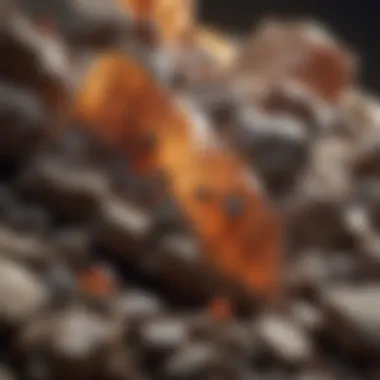Comprehensive Guide to Rock Mineral Identification


Intro
The earth we walk upon bears countless treasures just waiting to be uncovered. For those with a keen eye, understanding rock mineral identification is not merely a hobby; it’s a passage into the glorious depths of geological history. Each rock, crystal, or fossil tells a story, whispering secrets of epochs long gone.
Embarking on this journey, it’s vital to grasp the fundamentals—what characterizes a mineral, how they are formed, and the tools and methods used to identify them. In this guide, we’ll traverse through the fascinating landscape of minerals. From the shimmering sparkle of quartz to the rich hues of feldspar, every turn reveals something new. We’ll ensure that both novice collectors and seasoned geologists find this resource enriching.
Now, let’s lift the lid on the past, as history often sheds light on how we comprehend our present.
History and Origins
Overview of Collectibles, Rocks, and Fossils
Rock collecting isn’t a new pastime; it has roots stretching back to ancient civilizations. The allure of curious stones likely captured the interest of our ancestors who used them not just for tools, but also for ornamentation. People across cultures turned to the earth for not only practical necessities but also for beauty and meaning.
Our understanding of minerals and their classifications evolved gradually. The first significant strides were made in the early modern period, during the Renaissance, when scholars began to categorize natural specimens in a more systematic fashion. Many contributed their knowledge—Pliny the Elder in ancient Rome, and later, Georgius Agricola who meticulously documented mineral properties in the 16th century.
Historical Significance and Cultural Impact
Rocks and minerals have profoundly impacted societies for millennia. Take, for example, obsidian—this volcanic glass was prized for creating sharp tools in the Stone Age and has historical significance in various cultures as a material for crafting ceremonial items.
Fossils, too, provide key insights into our planetary tale. Consider the great dinosaurs or ancient marine life preserved in limestone. Each fossil tells us about the environment, climate, and life forms of its era, connecting us to a time when giant reptiles roamed the earth and lush forests thrived.
"The study of geology is much more than rocks; it’s a storybook of nature that requires careful reading to uncover its narrative."
To this day, the field of mineralogy remains dynamic. New discoveries frequently reshape our understanding, and with each collection, we contribute to this ongoing tale. Every pebble collected, every specimen studied feeds into the rich tapestry of human knowledge about the natural world.
Identification and Classification
Guide to Identifying Rocks and Fossils
Identifying a rock ain’t just about looking; it involves a keen eye and a touch of patience. To begin, familiarize yourself with some basic properties:
- Color: The initial impression can be deceptive. A mineral might present differently in various conditions.
- Streak: The color of the powder left when a mineral is dragged across a porcelain plate.
- Luster: Whether a mineral appears shiny or dull.
- Hardness: The resistance to scratching based on the Mohs scale.
- Cleavage and Fracture: How a mineral breaks—cleavage creates smooth surfaces, while fracture results in rugged edges.
Understanding these characteristics can make you a more adept collector.
Common Types and Variations
In the game of identification, some minerals stand out as rock stars—pun intended. Here are a few common types sure to catch your intrigue:
- Quartz: Known for its versatility, appearing in various colors.
- Feldspar: The workhorse of earth’s crust, abundant in igneous rocks.
- Mica: Characterized by its layered structure, perfect for peeling.
- Calcite: A primary player in sedimentary rock formation.
When it comes to fossils, some notable examples include:
- Ammonites: These captivating spiral shells tell tales of ancient seas.
- Trilobites: One of the first abundant complex life forms.
- Brachiopods: Evidence of life from hundreds of millions of years ago.
In crafting a collection that stands out, knowing your subject matter is essential. Each specimen holds a unique identity and significance within the larger context of Earth's geological narrative. As you expand your understanding, you’ll also deepen your appreciation for the remarkable planet we inhabit.
Understanding Mineralogy
Mineralogy is the cornerstone of geology, offering a framework through which we can comprehend the vast complexities of Earth’s materials. Understanding mineralogy equips rock and fossil collectors with the fundamental knowledge for identifying and categorizing the myriad minerals they may encounter in their pursuits. Through a keen grasp of mineral properties and behaviors, one can not only recognize minerals but also appreciate their significance in various geological contexts.
The basis of this understanding lies in a solid definition of minerals, which brings us to the next subsection.
Definition of Minerals
In simplest terms, a mineral is a naturally occurring, inorganic solid with a defined chemical composition and a crystalline structure. This definition, however, barely scratches the surface. Take a moment to consider, for example, quartz, which is composed of silicon dioxide (SiO₂). Its predictable crystal structure and physical properties make it easy to identify, yet within its simplicity lies a wealth of complexity.
To elaborate:
- Naturally Occurring: Minerals form through geological processes without human intervention. This means if you stumble upon a mineral, it could tell a story about the Earth’s history and processes that formed it.
- Inorganic Solid: This excludes materials like coal or wood, which come from once-living organisms. It emphasizes that minerals are part of the Earth's crust.
- Definite Chemical Composition: Each mineral is defined by its specific elements and their arrangements. For instance, if you find a rock resembling feldspar, you might be looking at a mixture of aluminum, silicon, and oxygen in varying proportions.
- Crystalline Structure: The internal arrangement of atoms in a mineral dictates its external shape and physical properties, which are crucial for identification.
Importance of Mineral Identification
Identifying minerals is not merely a scientific exercise; rather, it serves several pragmatic purposes that resonate with both enthusiasts and professionals alike.
First, a precise identification can yield valuable insights into the geological history of an area. For instance, discovering a unique mineral can indicate the presence of a specific geological process, such as volcanic activity or sedimentary deposition. This knowledge deepens your appreciation for the local geology and guides further exploration.
Moreover, understanding minerals contributes to various practical applications:
- Resource Exploration: Certain minerals are vital for industrial processes. Knowing how to identify them can lead to successful mining and resource extraction.
- Environmental Monitoring: Knowing mineral composition plays a role in tracking environmental changes and assessing soil health.
- Collectible Value: For rock and fossil collectors, the rarity and aesthetics of a mineral can greatly increase its market value. An astute identification can lead to acquiring not just examples, but prized specimens.
To encapsulate the essence of mineral identification, keep in mind this important thought:
"A mineral isn't just a part of the Earth; it's a window into the stories and processes that shape our planet."
Thus, the study of mineralogy becomes a gateway into deeper geological understanding, one that can enhance both personal and academic pursuits in the fascinating world of geology.
Key Properties of Minerals
Understanding the key properties of minerals is essential in rock and mineral identification. These properties help differentiate one mineral from another, providing critical clues that aid in recognizing and classifying the various minerals in our world. By examining factors such as physical and chemical properties, one can get an overall picture that simplifies the complex task of mineral identification.
Physical Properties


Physical properties are often the first indicators used when attempting to identify a mineral. Attributes such as color, streak, luster, hardness, and cleavage or fracture can reveal much about a mineral’s identity.
Color
Color might seem like the most straightforward way to identify a mineral, but it’s often misleading. Different minerals can exhibit a variety of colors due to impurities or other factors. For instance, quartz can be clear, milky, or even purple depending on the inclusions present. The key characteristic here is its variability, which makes color a less reliable indicator.
On the flip side, a mineral's typical color can help to narrow down possibilities. Something like malachite is well-known for its vibrant green hue, making it a fairly easy pick for enthusiasts. However, relying solely on color can lead to errors, stressing the need for additional properties in identification.
Streak
Streak involves observing the color of a mineral’s powder when it’s scraped against an unglazed porcelain plate. This method often reveals the true color of the mineral, free from impurities or surface weathering. A mineral like hematite, for example, may appear red in its crystal form but leaves a very different reddish-brown streak, which can be a great help in proper identification.
Thus, the streak test is a significant technique to put in your toolkit. While it may not apply to every mineral, especially those that are harder, it proves valuable in quickly verifying the identity of certain specimens.
Luster
Luster describes how a mineral interacts with light, and it can range from shiny to dull. Categories of luster include metallic, glassy, and pearly. For example, galena has a striking metallic luster that makes it distinct at a glance. Identifying a mineral’s luster narrows down the list of potential minerals significantly, serving as an excellent first step in the identification process.
That said, luster can sometimes be subjective and depend on one’s perspective, making it necessary to use this property in conjunction with others for accuracy.
Hardness
Hardness is perhaps one of the most definitive physical properties of minerals, as it indicates how resistant a mineral is to scratching. The Mohs scale, ranging from talc at one to diamond at ten, is the standard for measuring hardness. A mineral like calcite, which has a hardness of three, is easily scratched by a copper coin.
Understanding hardness is critical, particularly when differentiating between minerals that may appear similar. It serves as a vital characteristic that can help confirm or counter a potential identification, ensuring accuracy in the field.
Cleavage and Fracture
Cleavage refers to how a mineral breaks along specific planes of weakness. This property is distinct from fracture, which describes a more random breakage pattern. Minerals like mica exhibit perfect cleavage, splitting easily into thin sheets. In contrast, quartz breaks irregularly without any set planes.
Recognizing these patterns can aid immensely in identification. However, keep in mind that not all minerals will demonstrate clear cleavage or fracture, making this property another cog in the machine of mineral identification.
Chemical Properties
The chemical nature of a mineral is another layer that can clarify its identity. Chemical properties can be categorized into its composition, reactivity to certain substances, and its crystallization method.
Chemical Composition
Each mineral is globally characterized by its specific chemical formula, which indicates the elements present and their proportions. For instance, feldspar is primarily composed of silicon, aluminum, and oxygen. The clarity of a mineral's chemical composition often extends the understanding of its physical properties.
Furthermore, with the advancements in technology, understanding a mineral’s chemical composition can enhance the accuracy of identification techniques. However, it does require deeper knowledge of chemistry and may necessitate specialized equipment, which complicates processes for beginners.
Reactivity Tests
Reactivity tests notably involve observing a mineral’s response to acids or other chemicals. For example, calcite will effervesce when acid is applied, helping to confirm its identity quickly. However, not every mineral will react to acid, which means this step might not be applicable in every situation.
While these tests can provide quick answers, they should be approached cautiously. One must know which tests are appropriate for which minerals to avoid costly errors in identification.
Crystal Structure
The arrangement of atoms within a mineral defines its crystal structure, a feature that appears prominently under microscopic analysis. Different structures lead to various crystal shapes, providing easy visual clues to identification. A mineral like garnet presents in a distinct dodecahedral shape, making it relatively easy to pick out.
However, interpreting crystal forms can be complicated, requiring experience and familiarity. This complexity means crystal structure usually serves as a reinforcing element rather than a standalone identifier.
In summary, the key properties of minerals are indispensable in properly identifying them. By understanding and applying these physical and chemical characteristics, mineral enthusiasts can significantly enhance their identification skills.
Basic Identification Techniques
Identifying minerals requires a blend of keen observation and practical tools. The section on basic identification techniques is crucial for beginners and enthusiasts alike because it establishes the groundwork for further exploration into mineralogy. By employing straightforward methods, one can gain confidence in distinguishing between various rock-forming minerals without diving too deeply into complex analytical procedures immediately. These techniques emphasize visual cues and tactile interactions, making them accessible to a wide range of audiences.
Visual Inspection Methods
Visual inspection forms the backbone of mineral identification. By simply examining the physical attributes of a specimen, a wealth of information can be uncovered. Here, two prominent methods come into play: using hand lenses and identifying color variations.
Using Hand Lenses
Hand lenses are a handy tool—in fact, many rock collectors wouldn't leave home without one. These simple magnifying devices widen the visual field and enhance details that the naked eye might overlook. The primary advantage of using hand lenses is their portability and ease of use. Just a quick glance through one can reveal unique features like intricate crystal patterns or tiny inclusions that help differentiate between closely related minerals.
However, a keen observer must keep in mind that not all minerals will present a striking difference under magnification. Some, like quartz, may appear quite similar regardless of lens use. Despite this limitation, hand lenses remain a popular choice among novices and seasoned geologists due to their availability and utility in the field.
Identifying Color Variations
Color is often the first thing noted when examining a mineral. Identifying color variations is not just about recognizing a hue; it's about understanding that color can be deceiving. Many minerals can present in various colors due to impurities and environmental conditions. For example, pure calcite is colorless, but it can occur in shades ranging from red to green, depending on the metals it contains.
Thus, while color identification is indeed beneficial, it should be paired with other identifiers to confirm a mineral’s identity. Failing to consider these nuances can lead to misidentifications, making it a practice necessitating careful consideration.
Field Testing Tools
While visual methods can provide a good starting point, field testing tools further enhance identification capabilities. These instruments empower collectors to delve deeper, revealing properties that visual observation merely hints at.
Hardness Kits
A hardness kit is an essential asset for any serious collector. By employing a series of common materials, a hardness kit allows individuals to determine a mineral's resistance to scratching. Each mineral has a specific hardness rating on the Mohs scale, which provides a relative measure when compared to standard materials included in the kit.
One primary benefit is that it offers a tangible way to engage with a specimen. A curious mind can conduct a simple test with just a fingernail or a metal piece to gauge hardness. However, the drawback is that some minerals might be close in hardness, leading to inconclusive results. Understanding how to use this kit correctly is key to avoiding such pitfalls.


Acid Tests
Acid tests are another great technique, especially for carbonates. When weak acid, like vinegar, is applied to a carbonate mineral, effervescence indicates a reaction—this is a telling sign of calcite or dolomite presence. The advantage of acid tests lies in their straightforward execution and clarity of results.
Nevertheless, caution is warranted, as improper use can damage the specimen or lead to inaccurate readings. Therefore, collectors should familiarize themselves with safe practices and the appropriate conditions for conducting these tests.
Always take care to conduct acid tests in well-ventilated areas and wear protective gear to minimize risks.
In summary, the basic identification techniques equip enthusiasts with the foundational skills necessary for rock mineral examination. By using a combination of visual inspection methods and field testing tools, budding collectors can gain a broader understanding of minerals, ultimately leading to a more profound appreciation of the geological world.
Advanced Identification Techniques
Advanced identification techniques play a crucial role in the realm of mineral identification, adding layers of precision and accuracy that far surpass basic methods. While visual inspections and field testing tools can provide a solid foundation, these sophisticated approaches provide critical insights into the mineral's properties and composition. Understanding these techniques is vital for enthusiasts looking to deepen their skills in this fascinating field. They also help to clarify the distinctions between similar minerals, ensuring that collectors develop a more nuanced understanding of their specimens.
Mineral Identification Software
In an era where technology permeates almost every aspect of life, mineral identification software stands out as a powerful ally for rock and fossil collectors. It enhances traditional approaches by enabling users to input various mineral characteristics into a digital platform that will then suggest possible identifications based on a comprehensive database of known minerals. This can include factors like color, streak, hardness, and even location.
Using such software is often as straightforward as taking a photograph of the sample or entering details into an online tool. Not only does this optimize the identification process, but it can also lessen the fatigue and frustration that sometimes comes with manual identification. However, users must also be cautious.
"Technology is a tool, not a substitute for knowledge."
It's important to remember that the software's recommendations should be used alongside personal observations and interpretations. Moreover, connectivity issues or software errors can occasionally yield inaccurate results, thus stressing the continued importance of mastering traditional field techniques.
X-ray Diffraction Analysis
X-ray diffraction (XRD) analysis is arguably at the pinnacle of advanced mineral identification techniques. This method utilizes the principle of diffraction, where X-rays are fired at a crystalline substance. When the X-rays hit the mineral, they diffract in unique patterns which can offer unparalleled insights into the chemical structure and identity of the mineral.
The ability of XRD to provide precise and definitive mineral identification makes it invaluable, especially for complex samples or when working with micro-minerals where traditional methods fall short. Such an approach can distinguish between similar minerals, highlighting their unique crystalline structures and compositions. In geological research and industry, XRD analysis is considered a gold standard due to its accuracy.
However, this method does have its drawbacks. Equipment can be costly, requiring both financial investment and specialized training to interpret the results correctly. Moreover, it may not be feasible for hobbyists lacking access to advanced labs. Nonetheless, collaborations between collectors and academic institutions are becoming increasingly common, making XRD more accessible for those aiming for a deeper understanding of their specimens.
Common Rock-Forming Minerals
Understanding common rock-forming minerals is essential for anyone delving into the realm of geological studies and rock collections. These minerals serve as the backbone of the Earth’s crust, making them pivotal in understanding geological processes. Knowing the properties and identification techniques related to these minerals is not just an academic exercise; it's crucial for rock and fossil collectors who wish to build an impressive collection or pursue practical geological work.
Quartz
Quartz is arguably one of the most well-known and widely distributed minerals in the Earth’s crust. It consists mainly of silicon dioxide and is notable for its remarkable hardness, rated at 7 on the Mohs scale. This resilience makes quartz an important mineral to identify.
From a collector's perspective, quartz comes in a variety of forms, each with unique characteristics. Crystalline quartz, for instance, forms hexagonal prisms, reflecting light beautifully. Amethyst, a purple variety of quartz, and citrine, known for its yellow hues, are two examples of this mineral popular among collectors. When identifying quartz, pay close attention to its transparency, luster, and whether it exhibits any zoning or color variations.
Feldspar
Feldspar is another cornerstone of igneous rocks and can be classified into two main categories: plagioclase and alkali feldspars. Together, they make up approximately 60% of the Earth's crust. Feldspar's significance in mineral identification lies in its variety and how it behaves in different geological settings.
Plagioclase feldspar ranges from white to gray and exhibits a characteristic striated habit. Alkali feldspar, on the other hand, usually appears in pink or reddish shades. Collectors should note the hardness of feldspar, which is typically around 6-6.5 on the Mohs scale. Recognizing these variations and their optical properties can be instrumental in mineralogical studies.
Mica
Mica, specifically muscovite and biotite, are common in many rock types, particularly metamorphic rocks. Muscovite is silvery and transparent, while biotite is dark brown or black. Their perfect cleavage allows them to be easily split into thin sheets, lending them practical applications in various industries.
Mica is relatively lighter compared to other minerals, and its layered structure is easily identifiable under a hand lens. In terms of hardness, it’s rated around 2.5-3, thus making it one of the softer minerals to work with. In collections, mica can showcase stunning phyllosilicate formations, which can serve as a conversation piece.
Calcite
Calcite, a prominent mineral with the formula CaCO₃, exhibits a unique property: it reacts with dilute hydrochloric acid, effervescing upon contact. This characteristic makes calcite easier to identify in the field. Its crystal forms can vary widely—from rhombohedral to various granular aggregates—making it a mineral of great interest to collectors.
It's crucial to pay attention to calcite's optical properties, such as its birefringence or different refractive indices when light passes through it. On the Mohs scale, it ranks around 3, which means it's not the hardest but sturdy enough to be found in a variety of geological settings, from limestone to marble.
"Identifying common rock-forming minerals helps to unravel the Earth's history and offers a glimpse into its dynamic processes."
In the pursuit of mineral identification, understanding these four commonly found minerals—quartz, feldspar, mica, and calcite—will provide a solid footing for any enthusiast. These minerals not only contribute to the aesthetics of a collection but also enhance its scientific value, helping to bridge the gap between appreciation and understanding in the realm of geology.
The Role of Classification Systems
Classification systems serve as the backbone in the art and science of mineral identification. These systems bring order to a seemingly chaotic array of minerals, allowing collectors, geologists, and enthusiasts alike to understand and communicate about the diverse materials found in the Earth’s crust. At its core, the importance of these systems lies in their capacity to provide a framework for analyzing minerals based on their composition, properties, and relationships. When talking about a particular mineral, a well-established classification system ensures that everyone is on the same page, reducing the chances of confusion or misinformation.
A primary benefit of classification systems is that they aid in narrowing down the extensive list of minerals by organizing them into specific categories. For instance, knowing a mineral’s classification can help determine its likely physical and chemical properties. Furthermore, these systems allow for easier navigation of the vast mineral landscape, especially valuable for rock and fossil collectors who are often on the hunt for specific specimens.
However, it's crucial to consider some limitations. Not all minerals fit neatly into one category. Some may exhibit properties of multiple classification systems, making identification challenging. Additionally, changes in scientific understanding can lead to a reclassification of minerals, which collectors must stay abreast of. In summary, classification systems are indispensable for anyone involved in mineral identification, providing clarity and a structured approach to understanding the intricacies of the Earth's minerals.
Mineral Classification by Composition
The mineral classification by composition focuses on the chemical makeup of the minerals, grouping them into distinct categories based on their elemental composition. This method is fundamental, as even a slight change in a mineral's chemical structure can lead to significant differences in its characteristics and behavior. For instance, consider the difference between olivine and pyroxene: both belong to the silicate group but are differentiated by their magnesium and iron concentrations along with their crystal structures.
Here's a closer look at some common classifications based on composition:
- Silicates: Comprising the vast majority of the Earth's crust, silicates include minerals like quartz and feldspar. They have silica (SiO2) as a fundamental building block.
- Carbonates: These minerals, such as calcite and dolomite, are characterized by the presence of carbonate ions (CO3) in their structures.
- Oxides: This group features minerals primarily consisting of metal oxides, like hematite and magnetite, vital for various industrial applications.
This compositional classification not only aids in identification but also plays a key role in determining the geological processes that formed the minerals, giving deeper insights into Earth's history.
Uses of Classification Systems
Classification systems serve many practical uses in the realm of mineral identification. For mineral collectors, these systems can streamline the identification process by categorizing minerals into easily recognizable groups. As one begins to grasp the classification, it becomes easier to predict the types of minerals one might encounter in specific geological settings. This is particularly true in regions with well-known geological histories. Understanding whether the region is dominated by igneous, sedimentary, or metamorphic rocks can guide collectors toward more targeted searching.


Moreover, classification systems are pivotal in academic research and education where clear communication is essential. They enable researchers to share findings, compare results, and build upon each other’s work. By utilizing standardized terminology, scientists can engage in a meaningful dialogue that drives the field of mineralogy forward.
In practical applications, classification systems help in mining and resource management. Knowing the properties of various minerals is critical when evaluating their economic value and potential uses. For example, identifying minerals like bauxite, which is primarily composed of aluminum oxide, leads to its extraction for aluminum production.
Proper classification of minerals is not just about naming them; it's about understanding their role in our world, from academic research to practical applications.
In essence, the classification of minerals by composition and use is more than an academic exercise. It transforms how we interact with the mineral world, enriching both personal collections and broader scientific understanding.
Common Mistakes in Mineral Identification
Understanding common missteps in mineral identification is crucial for anyone, from amateurs to seasoned geologists. Often, it's these mistakes that can lead to misinformation about a mineral or rock’s actual identity, which in turn affects a person’s entire understanding of geology. By recognizing and addressing these pitfalls, enthusiasts can sharpen their identification skills, leading to more accurate assessments and a greater enjoyment of their geological pursuits.
Overreliance on Color
One of the biggest blunders in mineral identification is overestimating the importance of color. While color can be an identifying feature, many minerals come in a range of hues and variations that can mislead even the keenest collector. For instance, quartz may appear colorless, but it's found in a myriad of colors like amethyst or smokey quartz.
- Understanding Variability: Factors like impurities, oxidation, and exposure to different environmental conditions can change a mineral’s color. This variability introduces a layer of complexity that aspiring identifiers might overlook. For example, iron-rich minerals might alter their colors when reacted with water.
- Key Takeaway: Never rely solely on color. Always augment your observations with other properties, such as streak, luster, and hardness, to make a more informed identification.
Neglecting Physical Properties
Unfortunately, after color, many individuals tend to neglect the vital physical properties of minerals. Properties such as hardness, cleavage, and luster are fundamentally important. If you skip these characteristics, you might miss critical clues.
- Hardness: Assessing hardness using the Mohs scale can significantly enhance your identification process. A mineral that feels soft like talc can be easily confused with one that appears similar like certain forms of calcite.
- Cleavage and Fracture: The way a mineral breaks can provide major insights. Minerals like mica have distinct cleavage planes, while others like quartz show conchoidal fractures. Recognizing these patterns leads to a better understanding of how the mineral formed.
Not paying attention to physical properties can lead you down the wrong path entirely in the identification process.
In summary, when you step into the world of rock mineral identification, it's vital to approach with an eye for detail and a mind ready to question assumptions. By reducing overreliance on color and honing in on physical properties, you can make your journey into geology more rewarding and accurate.
The Importance of Proper Techniques
When it comes to rock mineral identification, the proper techniques can make a world of difference. It’s not just about knowing what to look for; it’s also about how you go about it. Techniques play a vital role in ensuring the accuracy of your findings and ultimately, your understanding of minerals. Mistakes made during the identification process can lead you down the wrong path. This can result not only in incorrect classifications but also in missed opportunities to expand your knowledge.
With the right techniques, you can gather rich data that will be invaluable for further study. Whether you are conducting research or simply collecting minerals as a hobby, getting your methods right is essential for making meaningful observations.
Accuracy in Collecting Data
Collecting data accurately is half the battle won in rock mineral identification. Each sample you gather harbors valuable information that can reveal its identity, origin, and even its place in the wider geological history. Moreover, being precise during this collection process minimizes errors in subsequent steps of identification.
Whether it be recording where you found the sample or noting its physical properties right on site, attention to detail cannot be overstated.
- Investing in Quality Tools: Investing in decent hand lenses or hardness kits can also help in collecting reliable data. These tools enhance your capability to observe and evaluate minerals effectively.
- Taking Notes: Maintain a thorough and organized log of your findings. Jot down not only the characteristics of the rock but also the environmental conditions at the time of collection. This often-overlooked aspect can provide context to your mineral identification process.
- Photographic Documentation: A picture is worth a thousand words. Keeping photographic records of your samples at various angles can offer details that might be missed during initial assessments.
"Documentation serves as the bedrock of quality mineral identification, ensuring that what you collect today is something you can analyze tomorrow."
Maintaining Controlled Conditions
In mineral identification, it pays to maintain controlled conditions. Factors such as temperature, humidity, and light can influence how minerals exhibit their properties. Some minerals react differently when they are exposed to changes in these variables. By controlling these conditions, you ensure that your identification results are consistent and reliable.
- Environment Matters: For example, storing your samples in a cool, dry place prevents moisture from causing degradation or changes in mineral structure. This kind of maintenance is crucial, especially for delicate specimens that might be sensitive to environmental influences.
- Consistent Testing Conditions: Whether you are conducting a field test using acid or examining mineral hardness, make sure that you replicate similar conditions for each test. Having a controlled setup aids in achieving reproducible results.
- Batch Testing: For larger collections or multiple samples, consider conducting tests in batches. This helps in maintaining uniformity across your samples, thus enhancing the accuracy of your findings.
In summary, understanding the importance of proper techniques in rock mineral identification not only augments your skill set but also enriches the overall experience of working with minerals. Getting it right the first time establishes a foundation for continuous learning and exploration in the geological realm.
Collecting and Documenting Samples
Collecting and documenting samples is a critical aspect of rock mineral identification. It’s not just about picking up stones; it’s about understanding the context from which they come. A well-collected sample can provide a wealth of information, helping to identify the specific mineral, its formation environment, and how it relates to other geological features. Successful identification hinges on the quality and contextual integrity of the sample.
When you set out to collect samples, it’s essential to have a strategy.
Best Practices for Collecting
- Know Your Environment: Before you grab your rock hammer, take time to study the area. Understanding the geological formations present and having knowledge about local mineral types will inform your collection efforts.
- Select Appropriate Tools: Bring the right tools to avoid damaging your samples. A rock hammer, hand lens, and sturdy gloves can make all the difference.
- Collect Responsibly: Care for the environment. Avoid over-collecting, particularly in sensitive areas; leave some specimens for future study and natural processes.
- Capture Context: When collecting, always note the location and surrounding features. Use GPS, or jot down landmarks to signify where you found the samples. Context is king.
- Limit Sample Size: Try to collect pieces that are substantial enough for identification but not so large that they become cumbersome to transport.
By honing in on these practices, collectors increase the odds of obtaining useful samples and contributing to their understanding of local geology.
Importance of Documentation
Documentation is where a good collecting trip transforms into valuable research. Here’s why it matters:
- Creates a Record: Keeping detailed notes of your finds allows for a reliable reference in the future. Write down colors, textures, and other pertinent physical properties.
- Facilitates Analysis: When you analyze your samples later, having established records helps ensure that you are making informed conclusions based on accurate data.
- Encourages Sharing: Well-documented samples enhance opportunities for collaboration. You can share your findings with fellow enthusiasts or researchers, assisting in collective knowledge.
- Promotes Personal Growth: Documenting your process teaches you more about mineral identification and enhances your observational skills over time. This leads to deeper geological understanding and appreciation.
"Good documentation creates a bridge between collecting samples and understanding minerals. It’s the difference between just having rocks and having a story to tell."
Ending and Future Explorations
In wrapping up our exploration into the realm of rock mineral identification, it's vital to reflect on the significance of the journey we have traversed. Understanding minerals isn't just a hobby; it’s a gateway to appreciating the very fabric of our planet. Recognizing the intricate details—from the chemical make-up to the physical characteristics—allows enthusiasts and collectors alike to develop a deeper connection to the earth’s processes. This understanding paves the way for future research and promotes active engagement in geological conservation efforts.
Summarizing Key Points
To reiterate the core concepts discussed, we have covered several key aspects:
- Mineral Properties: Recognizing the fundamental properties, such as color, hardness, and crystal structure, is essential.
- Identification Techniques: From basic visual inspections to advanced methods like X-ray diffraction, there are diverse techniques available at one's disposal.
- Common Rock-Forming Minerals: Familiarity with minerals like quartz, feldspar, and calcite is crucial; these make up much of the Earth's crust.
- Classification Systems: Understanding how various minerals are categorized helps in effective identification and further study.
This summary serves as a quick refresher, encapsulating the essentials that every rock and fossil collector should keep in their toolkit.
Encouraging Ongoing Learning
The realm of mineral identification is vast and always evolving. For those interested in furthering their knowledge, continuous learning is paramount. Here are some recommendations:
- Join Local Rock Hounding Groups: Being part of a community can provide valuable insights and hands-on experience. You can talk to others who share your passion and learn from their discoveries.
- Online Resources: Websites like Wikipedia and Britannica offer detailed articles on various minerals and identification strategies.
- Field Trips: Engage in fieldwork whenever possible. Observing minerals in their natural habitats strengthens your practical skills and expands your understanding.
- Participate in Workshops: Many geological societies offer workshops that focus on mineral identification techniques or the latest technology in the field.
Adopting an attitude of lifelong learning will not only enhance your skills but also enrich your appreciation of Earth's geological wonders. Remember, every stone has a story; delving deeper into rock mineral identification enriches that narrative as you discover the significance of each specimen.



